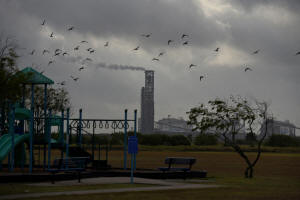Analysis-Global natural gas crisis dampens momentum for 'cleaner' LNG
 Send a link to a friend
Send a link to a friend
 [October 19, 2022] By
Nichola Groom, Emily Chow and Marwa Rashad [October 19, 2022] By
Nichola Groom, Emily Chow and Marwa Rashad
(Reuters) - Europe’s energy crisis has
cooled efforts to lower the carbon intensity of liquefied natural gas
(LNG) shipments, as buyers worried about a winter supply crunch
prioritize securing shipments of any kind over burnishing their green
credentials.
Natural gas can be certified as low- or no-carbon if its producers can
prove they have reduced greenhouse gas emissions associated with getting
it to market, or if they purchase carbon offsets to cut its net climate
impact.
But the number of deals to ship carbon neutral LNG around the world has
dropped to less than 10 so far this year, from 30 in 2021, according to
energy research firm Wood Mackenzie. And demand for the greener fuel has
dried up, according to Reuters interviews with nine LNG market analysts,
industry officials and traders.
“Lower carbon or carbon neutral LNG cargoes have lost their appeal in
the current high price environment," said Felix Booth, head of LNG at
energy analytics firm Vortexa. “Energy security and affordability is
front of mind for all buyers.”

The decline in international demand for the so-called “greener” gas is a
potential setback in the fight against climate change because it removes
a financial incentive for producers to reduce their climate impacts.
The market for such fuels had taken off a few years ago with a flurry of
international deals that sparked industry optimism producers would be
able to reliably cover their costs for cutting emissions or buying
offsets – which can run into millions of dollars per shipload.
A 2021 study by Columbia University’s Center on Global Energy Policy
pegged the premium on carbon-neutral LNG that year at about $1.75
million for a full cargo of around 100,000 cubic meters.
Several gas drillers, including in the world’s top gas producer the
United States, told Reuters they have invested in finding and plugging
greenhouse gas emissions associated with production, transport and
processing.
But no LNG exporters in the United States have certified their
facilities, according to both the liquefaction plant owners and
certification company MiQ, which had hoped to land contracts with them
this year.
Undermining the market are sanctions and disruptions stemming from
Russia’s war in Ukraine. Since Russia's Feb. 24 invasion of Ukraine, gas
prices have soared about 25% in the United States and 32% in Europe.
While gas produces fewer emissions than coal when burned, it can still
contribute significantly to climate change by leaking into the
atmosphere from drill pads, pipelines and other equipment. The main
component of gas is methane, a greenhouse gas more powerful than carbon
dioxide during its first 20 years in the atmosphere.
More than 100 countries have pledged to slash methane emissions by 2030
and are expected to detail their plans at a climate summit in Egypt next
month.
[to top of second column] |

A portion of the Cheniere Texas LNG
facility is seen from a playground near a residential neighborhood
in Portland, Texas, U.S., June 13, 2022. REUTERS/Callaghan
O'Hare/File Photo

SOME DRILLERS FORGE AHEAD
Despite the drop in demand for greener LNG, many drillers are
tamping down their methane leaks, under pressure from regulators,
investors, and big customers.
About a quarter of gas drilled in the United States is being
certified to reflect its improved emissions intensity, by companies
like Project Canary and MiQ, according to those firms. About a third
of U.S. supply should be certified by the end of the year.
Civitas Resources Inc, a Colorado driller, for example, said it has
continued to measure emissions from its operations and certify its
facilities even though it stopped seeking price premiums.
“As this market evolves, we believe there will be long-term demand
for certifiably cleaner natural gas products," Civitas Chief
Sustainability Officer Brian Cain said.
Drillers EQT Corp and Chesapeake Energy Corp are among the other
U.S. gas producers certifying supply.
But exporters of gas appear to be lagging.
To export gas, the fuel must be supercooled into LNG and then
shipped across the sea, a process that produces substantial
additional greenhouse gas emissions.
MiQ early this year said it expected to be certifying U.S. LNG
cargoes within months. To date, however, U.S. LNG companies have yet
to certify their facilities.
Cheniere Energy Inc, the top U.S. LNG producer, said it has provided
emissions information for all cargoes shipped since June, but has
not partnered with third-party certification programs.
It declined to disclose the emissions details of its shipments to
Reuters.

Other U.S. LNG suppliers, like Cove Point LNG and Cameron LNG, also
told Reuters they are not certifying their cargoes.
Vincent Demoury, secretary general of the International Group of
Liquefied Natural Gas Importers (GIIGNL), said LNG exporters may be
hesitating because passing on the cost of carbon offsets is
difficult in a high-priced environment. But he said he expected the
outlook to eventually improve.
(Reporting by Nichola Groom in Los Angeles, Emily Chow in Singapore
and Marwa Rashad in London; Additional reporting by Yuka Obayashi in
Tokyo; editing by Timothy Gardner and Marguerita Choy)
[© 2022 Thomson Reuters. All rights
reserved.]
This material may not be published,
broadcast, rewritten or redistributed.
Thompson Reuters is solely responsible for this content. |